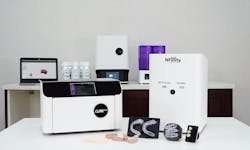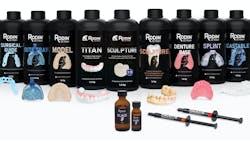Postprocessing workflows in 3D printing
The introduction of CAD/CAM in dentistry saw the integration of various types of manufacturing technologies in the production of dental appliances and restorations. Early equipment used in additive and subtractive manufacturing was, however, largely lab based, and this meant that workflows were well regulated and managed.
Milling technology was the first to make an appearance chairside, and for over two decades, the dental profession has been able to mill multiple restorations and appliances. Milling is also easily regulated as a technology due to the high precision required in the manufacture of equipment and the ease of control of milling substrates.
You may also be interested in ... Talking digital workflows and 3D printing: "Nothing has transformed dentistry this much"
Additive manufacturing was also initially lab based, cost prohibitive, and well regulated. However, the last five years have seen the introduction of in-practice additive manufacturing equipment, and many chairside 3D printers have been purpose-built for the dental market. This has resulted in the availability of cost-effective equipment and many different types of application-specific printing resins (figure 1). The advent of open-printing ecosystems, cross-compatible printing resins, and customizable resin profiles have all meant that the market has suddenly become more challenging to regulate.
This is most obvious in postprinting processing, where restorations and appliances that have not been adequately processed in accordance with instructions prescribed in a validated workflow can easily or inadvertently be delivered to a patient. The consequences can range from accelerated wear to fractured restorations/appliances at the lower end of the spectrum. There can also be far more significant consequences if one takes toxicity and potential carcinogenicity into consideration.
There has probably never been a bigger case for the use of validated workflows, and this is especially true in postprocessing. Proper postprocessing of 3D prints ensures complete cure and achievement of optimal physical properties.
Consequences of inadequate postprocessing
Multiple studies have evaluated the effect of postprinting alcohol rinses and various curing techniques and technologies that affect resin polymerization. Printing resins have complex chemical formulas and contain multiple oligomers of varying molecular weight, monomers, and photopolymerization initiators. When exposed to the right wavelength of light, the photoinitiators react with the oligomers and monomers, resulting in polymerization.
When the quality of the light source is compromised in any way, it can lead to inadequately cured resin and, ultimately, printing failure. Even when a print is adequately cured and polymerized in the printer and intended morphological form is achieved, the nature of resin 3D printing means there will always be a layer of uncured resin on the surface of the print. Postprocessing fundamentally ensures the removal of this layer by initial alcohol rinsing and eventual cure of the print surface with an appropriate curing technique.
With today’s printing resins, there's the challenge of heavily filled resins that don't allow extensive alcohol rinsing, as this can also remove resin from in between the filler particles and result in exposure of the filler layer. The printing industry doesn't conform to a single curing wavelength, which means that a given curing technology may not necessarily be compatible with every printing resin on the market.
It’s easy to see that inadequate rinsing and/or curing can result in less-than-optimal physical properties and influence mechanical behavior. When factors such as flexural strength, elastic modulus, surface hardness, and fracture toughness are affected by inadequate postprocessing, unpredictable clinical behavior of these materials can occur, such as fractured restorations and appliances, reduced clinical longevity, increased wear, discoloration, poor esthetics, staining, surface plaque accumulation, and water absorption. Inadequate postprocessing can also cause biologic leaching of residual monomers and other chemical constituents of the resin.
Cell culture studies have shown demonstrable cytotoxicity with these materials. There is an obvious need to ensure that they are not biologically available in processed prints. Biological effects have varied between demonstrable cellular toxicity and potential carcinogenicity. While the effects may be slow and not immediately obvious, it does not take away from their seriousness. There is currently no clarity regarding toxicity from resin vapors and other by-products of 3D printing that could potentially affect personal health and safety in the dental practice environment.
The first step: Alcohol rinsing
Rinsing in isopropyl alcohol is the first step in the postprocessing sequence and removes residual uncured resin on the surface of a 3D print. Several manufacturers have made a case for a two-compartment rinsing machine that ensures the print is shifted from a relatively highly contaminated alcohol wash to one that is less contaminated. This removes not only residual resin but surface contaminants as well.
Some manufacturers have made a case for keeping rinsing tanks for different prints from different resins separate from one another to ensure that there is no contamination. There may be a case for this, particularly for use of resins that are shade or color sensitive. Manufacturers typically prescribe rinsing times, and various machines have different wash intensities. The effect of these factors on the quality of resin removal is still unclear, but it is considered acceptable if the final curing method ensures complete polymerization.
You may also be interested in ... The true impact of 3D printing
Manufacturers of highly filled resins, such as ceramic filled resins, have started to prescribe no more than an alcohol spray and wipe of their final prints, because a white filler residue results when these prints are washed using routine protocols. This white layer is largely comprised of exposed fillers that tend to be difficult to remove or polish off, especially when there are dimensional considerations. It is presumed that a spray-and-wipe technique removes the superficial layer of uncured resin without removing resin from in between the filler particles. The uncured resin in between filler particles is managed by a prescribed curing method that ensures full polymerization.
In relatively larger production facilities, such as large practices or dental labs, changing the rinsing alcohol more frequently is recommended. Strict adherence to the rinsing times prescribed by resin manufacturers must be top of mind to ensure uncured resin removal. Rinsing does not completely eliminate uncured resin; an oxygen-inhibited layer will continue to abide on the surface of the print. Rinsing is also critically important in designs that can have pooled resin (such as prints having a hollow structure) or designs containing channels (such as implant screw access channels).
While most rinsing in 3D printing is done with isopropyl alcohol, there are safety issues. An IPA-free, biodegradable, organic, fume-free, and nonhazardous cleaning solution for 3D printing resins has recently been introduced to the market. This new rinsing alternative claims to have a much longer life.
The mechanism of action of rinsing machines is important in removal of the remaining resin. Some rinsing machines utilize ultrasonic activation, a centrifugal force, or a multijet spray to increase efficacy. The duration of rinsing has also been shown to have an effect on the resin matrix and the polymer network; excessive rinsing can affect physical properties.
The final step: Curing
Curing is the final step in postprocessing and is possibly the most important workflow process to ensure the 3D-printed resins are safe for use. A variety of factors affect the quality of cure with 3D printing resins. The most important consideration may be wavelength; curing units could potentially have either a multimatrix light source that covers a large spectrum or a single wavelength light source that limits the number of resins that can be cured in a certain unit. Most 3D printing resins are either 365 nm, 385 nm, or 405 nm. Regardless of whether a curing unit produces light of a certain wavelength for a given resin, it is extremely important that curing units are validated by a manufacturer for a specific resin.
See general workflow recommendations below.
The intensity of light produced from a light source in a curing unit can also affect the outcome. Intensity affects both depth of cure and duration. Certain curing units can achieve extremely fast curing times by combining high-intensity flashing LEDs with a nitrogen-infused environment. Nitrogen acts by scavenging oxygen in the curing chamber and produces a predictable surface cure without the oxygen-inhibited layer commonly observed in resins that have been inadequately cured in a normal environment.
Certain 3D printing resins have been shown to achieve more optimal physical properties when they are cured at a higher-than-normal temperature. In some resins, the higher temperature increases free monomer diffusion and cross-linking, which in turn leads to faster polymerization. The quality of cure is more homogenous, resulting in better physical properties.
Resin chemistry has an indirect effect on the quality of cure and the validation of the curing method. Photo initiators in 3D printing resins are directly responsible for how a given resin is cured, and different photoinitiators naturally result in different curing processes.
Postprocessing workflows must ensure quality
Postprocessing workflows with 3D printing are critically important in achieving optimal physical properties as well as fully cured resins with no residual monomers. This is especially important if a resin is being used to create an appliance that will reside intraorally for any length of time. Dental professionals need to understand manufacturer’s recommendations and follow them precisely.
Editor's note: This article appeared in the November 2023 print edition of Dental Economics magazine. Dentists in North America are eligible for a complimentary print subscription. Sign up here.
Nitish Surathu, MDS, BDS, practices in New Zealand. He is an associate fellow of the American Academy of Implant Dentistry, and a fellow and diplomate of the International Congress of Oral Implantologists. He has lectured internationally on periodontics, dental implants, and digital dentistry. Dr. Surathu is a director with the ACE Institute and digitaldentition.com, and is involved in evaluating new-generation digital technologies.
Neeraj Surathu, BDS, is a current postgraduate prosthodontic resident at Nova Southeastern University in Florida. After completing his BDS, he went on to work as a dental lab technician in New Zealand, where much of his work revolved around digital workflows. His interest in digital dentistry saw him commence a formal postgraduate prosthodontics program in 2021. Dr. Surathu has a keen interest in all things dental and digital besides surgical prosthodontics and artificial intelligence.
About the Author

Neeraj Surathu, BDS
Neeraj Surathu, BDS, is a current postgraduate prosthodontic resident at Nova Southeastern University in Florida. After completing his BDS, he went on to work as a dental lab technician in New Zealand, where much of his work revolved around digital workflows. His interest in digital dentistry saw him commence a formal postgraduate prosthodontics program in 2021. Dr. Surathu has a keen interest in all things dental and digital besides surgical prosthodontics and artificial intelligence.

Nitish Surathu, MDS, BDS
Nitish Surathu, MDS, BDS, practices in New Zealand. He is an associate fellow of the American Academy of Implant Dentistry, and a fellow and diplomate of the International Congress of Oral Implantologists. He has lectured internationally on periodontics, dental implants, and digital dentistry. Dr. Surathu is a director with the ACE Institute and digitaldentition.com, and is involved in evaluating new-generation digital technologies.
Updated June 7, 2023


